Aksharam is a unique museum exploring the origins, evolution, and cultural significance of language. Its first phase, now open, includes four interactive galleries with advanced technologies like holograms and an immersive theatre, bringing history to life
Published Dec 10, 2024 | 9:00 AM ⚊ Updated Dec 10, 2024 | 9:00 AM
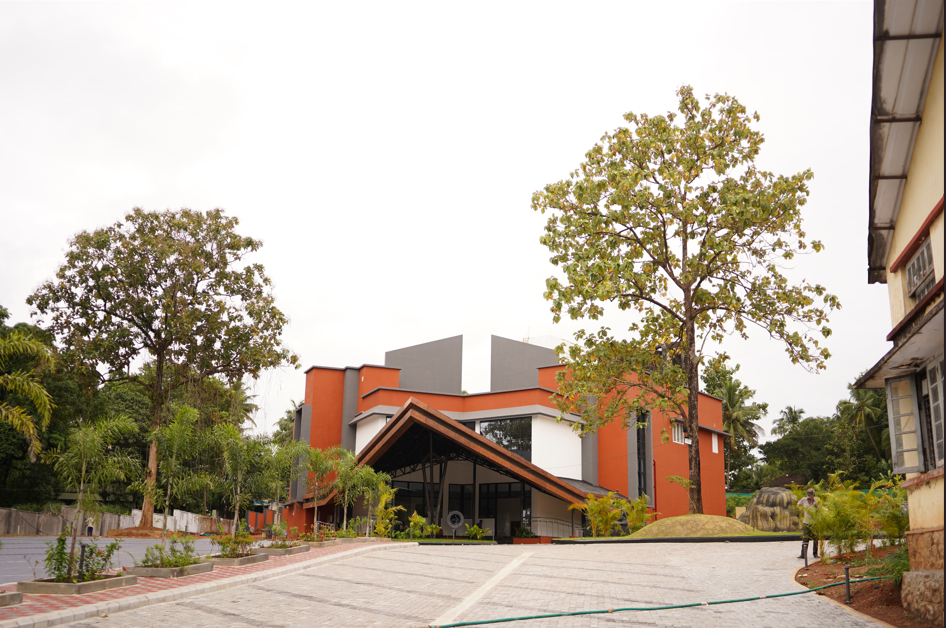
Aksharam
In an era when the push for linguistic uniformity looms large, Kerala has taken a bold step in defence of diversity by unveiling Aksharam, India’s first museum dedicated to language, literature, and culture.
Coming up aptly in Kottayam — revered as the Land of Letters — this 25,000-square-foot marvel in Nattakom was inaugurated by Chief Minister Pinarayi Vijayan on November 26.
Aksharam stands as both a celebration of the written word and a defiant statement against homogenisation, reminding India of the enduring power of language to preserve culture, history, and identity.
Unlike traditional museums centered on art or archaeology, Aksharam is a pioneering institution that delves deep into the origins, evolution, and cultural significance of language.
The first phase, now open to the public, features four galleries equipped with advanced technological aids, including holograms and an immersive theater, making history come alive for visitors.
The journey begins in the Origins of Language gallery, which explores humanity’s earliest attempts at communication. From primitive oral traditions to intricate cave paintings and ancient hieroglyphics, this section offers a fascinating glimpse into how language began.

Logo – Aksharam
The second gallery transitions to the evolution of Indian scripts, meticulously documenting their transformation across centuries. This gallery focuses on the richness of linguistic diversity in India.
The third gallery pays homage to the history of Malayalam printing, showcasing technological milestones that revolutionised the dissemination of knowledge. Iconic literary works that shaped the language and its culture are prominently displayed.
A particular highlight is the fourth gallery, which celebrates the contributions of the Sahitya Pravarthaka Cooperative Society (SPCS), the institution behind the museum.
Established in 1945, this cooperative has played a pivotal role in nurturing Kerala’s literary ecosystem.
The gallery also showcases the state’s groundbreaking literacy revolution and its 36 tribal languages, connecting visitors with the Dravidian linguistic family through multimedia exhibits.
Beyond Kerala’s linguistic treasures, the museum’s first floor houses a Language Gallery offering a global perspective.
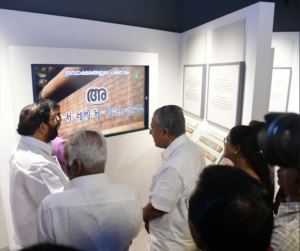
CM Pinarayi Vijayan visiting one of the galleries
Visitors are introduced to the over 6,000 languages spoken across the world, with detailed charts illustrating the chronological evolution of Indian scripts.
This exhibit underscores the shared roots of many linguistic traditions, fostering an appreciation for the interconnectedness of human expression.
One of the museum’s standout features will be the chance to hear the voices of beloved authors.
Visitors can listen to a three-to-four-minute recording of the late author and academician Karoor Neelakanta Pillai narrating a passage from one of his works.
Plans are also underway to include recordings of renowned Jnanpith Award winner Thakazhi Sivasankara Pillai and Ponkunnam Varkey, a pioneer of Kerala’s living literature movement, making the experience even more enriching.
In its second stage, the museum will introduce vibrant galleries dedicated to the evolution of Malayalam poetry.
The exhibit will trace the journey of poetry from its earliest forms to the modern era, showcasing a wide range of styles and traditions.
From folk poems, Sangam-era compositions, and Pattuprasthanam works to Manipravalam verses, Champoos, Thullal poems, sonnets, and elegies, the galleries promise to be a treat for literature lovers.
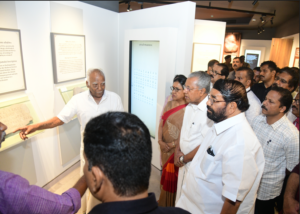
CM watching one of the exhibits at the museum
Designed as “edutainment panoramas,” the exhibits will combine education and entertainment to bring the magic of poetry to life.
The third stage will shine a spotlight on Malayalam prose, offering a deep dive into its versatility and evolution. Visitors will get to explore the roots of fictional literature that gained prominence through the influence of Western modernism.
The exhibits will also highlight the age-old storytelling traditions of folklore and performing arts, which laid the foundation for fiction in Malayalam.
Additional galleries will focus on various prose forms such as biographies, autobiographies, travelogues, and children’s literature, showcasing their unique contribution to the literary landscape.
The museum’s fourth stage will be dedicated to Malayalam’s scholarly literature.
It will feature galleries on language, grammar, astrology, philosophy, law, history, mathematics, and other academic disciplines, demonstrating how these works have shaped society.
Recognising the pivotal role of translation in broadening literary horizons, the museum will also include a special gallery highlighting translations to and from Malayalam.
One of Aksharam’s standout initiatives is the Letter Tourism Circuit, a curated route linking Kottayam’s most iconic literary and cultural landmarks.
This circuit connects visitors with historic sites such as the CMS Press, the birthplace of Malayalam printing, and Kottayam Valiyapally, renowned for its ancient cross bearing Pahlavi inscriptions.
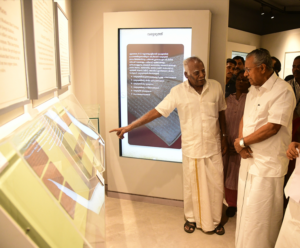
One of the exhibits at the museum
Other notable stops include the Kumaranellur Devi Temple, known for its palm-leaf manuscripts, and the Mannanam St. Joseph Press, one of Kerala’s earliest printing establishments.
Together, these destinations provide a holistic experience, blending history, spirituality, and the evolution of language.
Earlier, at the inauguration ceremony at the India Press House in Mariyappally, Chief Minister Pinarayi Vijayan underscored the museum’s cultural and political significance.
In his address, he framed Aksharam as a creative counter-narrative to the growing attempts at linguistic imposition in India.
“Efforts are underway to erase linguistic diversity and marginalise regional languages like Malayalam,” he remarked. “Aksharam stands as a beacon of cultural preservation and innovation, asserting Kerala’s commitment to safeguarding its linguistic and literary heritage.”
The Chief Minister emphasised that Aksharam goes beyond being a mere repository of language artifacts.
“This museum chronicles the legacy of language and literature, inspiring pride in our linguistic heritage while fostering awareness of our cultural roots. It is not just about preservation but also about innovation and education.”
Talking to South First, an official of SPCS said, “By showcasing the evolution of languages, their roots, and the ways they have shaped cultures and societies, the museum can inspire a deep appreciation for the uniqueness of each language.”
The official also shared the hope that such a museum would remind people of the beauty of multilingualism and the richness it brings to a nation.
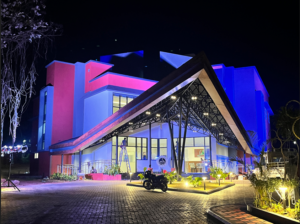
A night view of the museum
“It can encourage communities to protect their native languages and pass them on to future generations. By understanding the importance of preserving linguistic heritage, people may see the value in resisting the dominance of any single language, ensuring a balanced and inclusive society where all languages thrive,” he said.
For Kerala, Aksharam is not just a museum — it is a statement, an initiative to make the people realise the importance of protecting the nation’s linguistic diversity.
By intertwining Kerala’s rich literary history with the global evolution of language, Aksharam invites people to delve into the roots of language while embracing its role in shaping identity and culture.
(Edited by Rosamma Thomas)
